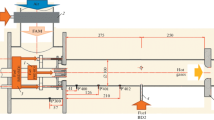Abstract
A mathematical model of the hydrocarbon fuel channel flow taking into account coke precursor deposit formation on the walls of aeroengine cooling systems and chemical transformations in the gas phase is presented. The model is based on the Navier—Stokes and Maxwell equations in the electric potential form. The description in the form of a radical-chain mechanism is used for the partial liquid-phase oxidation of hydrocarbons. The effect of the electric field intensity (E = 100—2000 V m–1) on the formation of coke precursors at different temperatures of the channel walls T w is shown. The calculations in the range of wall temperatures 350 < T w < 600 K showed that the temperature was the major factor affecting the deposit intensity. The influence of the electrostatic field on the deposit intensity is significantly lower: the difference in the weights of coke deposits for the variants with E = 0 and E = 2000 V m–1 differs by 10% on the average.
Similar content being viewed by others
References
T. N. Mukhina, N. L. Barabanov, S. E. Babash, V. A. Men’shchikov, G. L. Avrekh, Piroliz uglevodorodnogo syr’ya [Pyrolysis of Crude Hydrocarbons], Khimiya, Moscow, 1987, 240 pp. (in Russian).
CFD-ACE Modules Manual [Elektronnyi resurs]// ofitsial’nyi portal pol’zovatelei PO Esi-Group. Dostup dlya litsenzirovannykh pol’zovatelei. Sist. trebovaniya: Adobe Acrobat Reader 4 i vyshe [[Electronic resource]// official users portal PO Esi-Group. Access for licensed users. Systematic requirements: Adobe Acrobat Reader 4 and higher]; www.esi-cfd.com (in Russian).
A. Kulikovskii, G. Lyubimov, Magnitnaya gidrodinamika [Magnetic Hydrodynamics], Logos, Moscow, 2005, 328 pp. (in Russian).
R. O. Dendy, Plasma Dynamics, Clarendon Press, Oxford, 2002, 172 pp.
A. S. Myakochin, L. S. Yanovskiy, Obrazovanie otlozhenii v toplivnykh sistemakh silovykh ustanovok i metody ikh podavleniya [Deposit Formation in Fuel Systems of Power Plants], Izd-vo MAI, Moscow, 2001, 224 pp. (in Russian).
N. M. Emanuel’, G. E. Zaikov, Z. K. Maizus, Rol’ sredy v radikal’no-tsepnykh reaktsiyakh okisleniya organicheskikh soedinenii [The Role of Medium in Radical-Chain Oxidation Reactions of Organic Compounds], Nauka, Moscow, 1973, 279 pp. (in Russian).
J. Т. Shah, Е. В. Stuart, К. D. Sheth, Ind. Eng. Сhеm. Proc. Des. Devel., 1976, 15, 518—524.
A. Aarna, V. Vasil’ev, Yu. N. Zhiryakov, Izv. Akad. Nauk ESSR, Ser. Khim. [Bull. Acad. Sci. Estonian SSR (Engl. Transl.)], 1984, 33, No. 21, 39–45.
Author information
Authors and Affiliations
Corresponding author
Rights and permissions
About this article
Cite this article
Toktaliev, P.D., Martynenko, S.I., Yanovskiy, L.S. et al. Features of model hydrocarbon fuel oxidation for channel flow in the presence of electrostatic field. Russ Chem Bull 65, 2011–2017 (2016). https://doi.org/10.1007/s11172-016-1545-2
Received:
Published:
Issue Date:
DOI: https://doi.org/10.1007/s11172-016-1545-2



